Science with the ASTRI Mini-Array: From Experiment to Open Observatory
Abstract
1. Introduction
2. The ASTRI Mini-Array
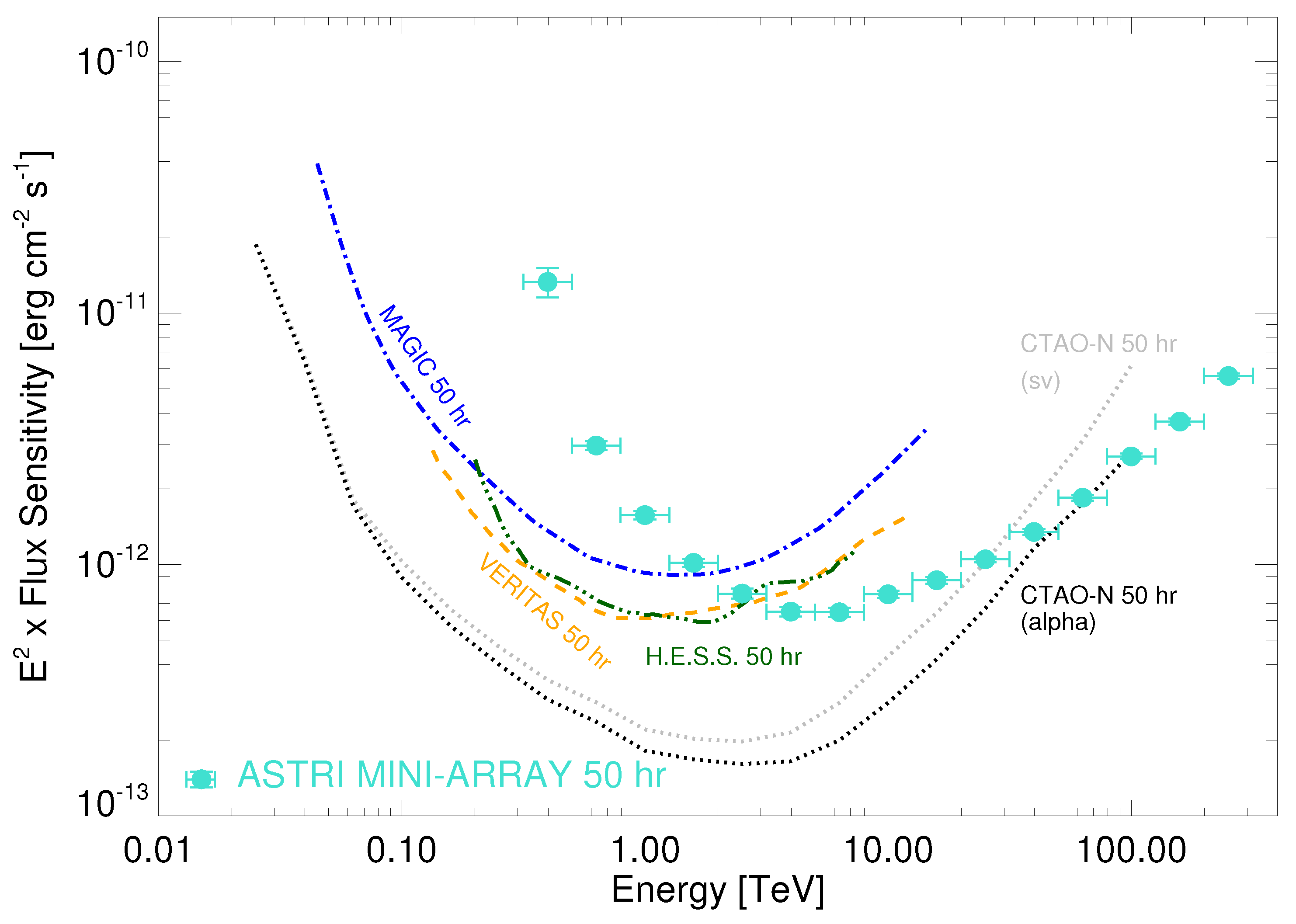
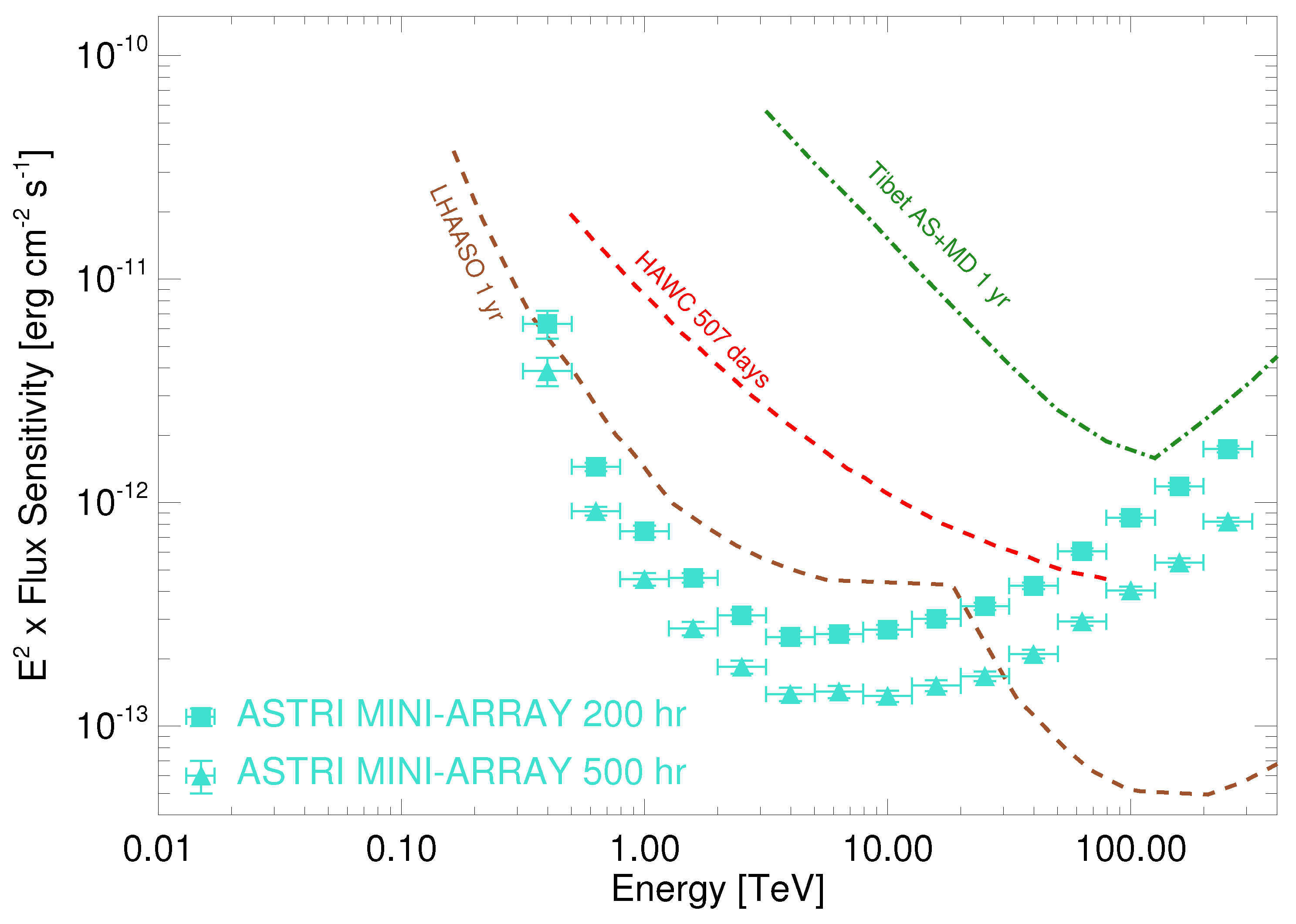
3. Core Science Topics
3.1. The Origin of Cosmic Rays
3.2. Cosmology and Fundamental Physics
3.3. Multi-Messenger and Time-Domain Astrophysics
3.4. Non -ray Astrophysics
3.5. Synergies with Other Facilities
4. The Observatory Phase
4.1. Cygnus Region Mini-Survey
4.2. Gamma-Ray Binaries—LS 5039
4.3. Spectral Features—Mrk 501
4.4. Disentangling Spectral Models in Misaligned Jetted Sources—NGC 1068
5. Conclusions
Funding
Data Availability Statement
Acknowledgments
Conflicts of Interest
Abbreviations
| ALP | Axion-like particles |
| AS- | Air shower -ray array |
| ASTRI | Astrofisica con specchi a tecnologia replicante italiana |
| C.L. | Confidence Limit |
| CTAO | Čerenkov telescope array Observatory |
| DM | Dark matter |
| EAS | Extended air showers arrays |
| ESA | European space agency |
| EBL | Extra-galactic background light |
| E-HBL | Extreme high-peaked BL Lacs |
| eROSITA | Extended Roentgen survey with an imaging telescope array |
| FOV | Field of view |
| FR | Fanaroff–Riley galaxies |
| FSRQ | Flat-spectrum radio quasar |
| GASP | GLAST-AGILE support programme |
| GRB | Gamma-ray burst |
| GW | Gravitational wave |
| HAWC | High-altitude water Čerenkov observatory |
| HB | Hadron Beam |
| HBL | High-peaked BL Lacs |
| HE | High-energy |
| H.E.S.S. | High-energy stereoscopic system |
| IAC | Instituto de Astrofísica de Canarias |
| IACT | Imaging atmospheric Čerenkov telescope arrays |
| IBL | Intermediate-peaked BL Lacs |
| IGMF | Inter-galactic magnetic field |
| IR | Infra-red |
| IXPE | Imaging X-ray polarimetry explorer |
| LHAASO | Large high-altitude air shower observatory |
| LIV | Lorentz invariance violation |
| LST | Large-sized telescope |
| MAGIC | Major atmospheric gamma-ray imaging Čerenkov telescopes |
| MST | Medium-sized telescope |
| NASA | National aeronautics and space administration |
| SBG | Star-bursting galaxies |
| SC | Schwarzschild-Couder |
| SII | Stellar intensity interferometry |
| SRT | Sardinia radio telescope |
| SST | Small-sized telescope |
| TNG | Telescopio Nazionale Galileo |
| VERITAS | Very energetic radiation imaging telescope array system |
| VHE | Very high-energy |
| WEBT | Whole-Earth blazar telescope |
| 1 | http://tevcat.uchicago.edu/, accessed on 14 February 2024. |
| 2 | Large-sized telescopes. |
| 3 | Medium-sized telescopes. |
| 4 | As noted in [33], a 1.1 PeV photon requires a parent electron of energy E∼2.3 PeV. |
| 5 | GRB 160821B and GRB 201015A have been detected at a significance of ∼3.1 and ∼3.5 , respectively, contrary to all the other GRBs whose detection significance exceeds ∼5 . |
| 6 | More detailed, phase-resolved spectra could not be investigated given the short exposure times in each phase bin. |
References
- Wakely, S.P.; Horan, D. TeVCat: An online catalog for Very High Energy Gamma-Ray Astronomy. Int. Cosm. Ray Conf. 2008, 3, 1341–1344. [Google Scholar]
- Aharonian, F.; Akhperjanian, A.G.; Bazer-Bachi, A.R.; Beilicke, M.; Benbow, W.; Berge, D.; Bernlöhr, K.; Boisson, C.; Bolz, O.; Borrel, V.; et al. Observations of the Crab nebula with HESS. A&A 2006, 457, 899–915. [Google Scholar] [CrossRef]
- Aleksić, J.; Alvarez, E.A.; Antonelli, L.A.; Antoranz, P.; Asensio, M.; Backes, M.; Barrio, J.A.; Bastieri, D.; Becerra González, J.; Bednarek, W.; et al. Performance of the MAGIC stereo system obtained with Crab Nebula data. Astropart. Phys. 2012, 35, 435–448. [Google Scholar] [CrossRef]
- Weekes, T.C.; Badran, H.; Biller, S.D.; Bond, I.; Bradbury, S.; Buckley, J.; Carter-Lewis, D.; Catanese, M.; Criswell, S.; Cui, W.; et al. VERITAS: The Very Energetic Radiation Imaging Telescope Array System. Astropart. Phys. 2002, 17, 221–243. [Google Scholar] [CrossRef]
- Abeysekara, A.U.; Albert, A.; Alfaro, R.; Alvarez, C.; Álvarez, J.D.; Arceo, R.; Arteaga-Velázquez, J.C.; Ayala Solares, H.A.; Barber, A.S.; Bautista-Elivar, N.; et al. Observation of the Crab Nebula with the HAWC Gamma-Ray Observatory. Astrophys. J. 2017, 843, 39. [Google Scholar] [CrossRef]
- Cao, Z. A future project at tibet: The large high altitude air shower observatory (LHAASO). Chin. Phys. C 2010, 34, 249–252. [Google Scholar] [CrossRef]
- Amenomori, M.; Bi, X.J.; Chen, D.; Chen, T.L.; Chen, W.Y.; Cui, S.W.; Danzengluobu; Ding, L.K.; Feng, C.F.; Feng, Z.; et al. Search for Gamma Rays above 100 TeV from the Crab Nebula with the Tibet Air Shower Array and the 100 m2 muon Detector. Astrophys. J. 2015, 813, 98. [Google Scholar] [CrossRef]
- Cherenkov Telescope Array Consortium; Acharya, B.S.; Agudo, I.; Al Samarai, I.; Alfaro, R.; Alfaro, J.; Alispach, C.; Alves Batista, R.; Amans, J.P.; Amato, E.; et al. Science with the Cherenkov Telescope Array; World Scientific: Singapore, 2019. [Google Scholar] [CrossRef]
- Gueta, O. The Cherenkov Telescope Array: Layout, design and performance. In Proceedings of the 37th International Cosmic Ray Conference, Virtual, 12–23 July 2022; p. 885. [Google Scholar] [CrossRef]
- Scuderi, S. The ASTRI Program. Eur. Phys. J. Web Conf. 2019, 209, 01001. [Google Scholar] [CrossRef]
- Giro, E.; Canestrari, R.; Sironi, G.; Antolini, E.; Conconi, P.; Fermino, C.E.; Gargano, C.; Rodeghiero, G.; Russo, F.; Scuderi, S.; et al. First optical validation of a Schwarzschild Couder telescope: The ASTRI SST-2M Cherenkov telescope. A&A 2017, 608, A86. [Google Scholar] [CrossRef]
- Lombardi, S.; Catalano, O.; Scuderi, S.; Antonelli, L.A.; Pareschi, G.; Antolini, E.; Arrabito, L.; Bellassai, G.; Bernlöhr, K.; Bigongiari, C.; et al. First detection of the Crab Nebula at TeV energies with a Cherenkov telescope in a dual-mirror Schwarzschild-Couder configuration: The ASTRI-Horn telescope. A&A 2020, 634, A22. [Google Scholar] [CrossRef]
- Scuderi, S.; Giuliani, A.; Pareschi, G.; Tosti, G.; Catalano, O.; Amato, E.; Antonelli, L.A.; Becerra Gonzàles, J.; Bellassai, G.; Bigongiari, C.; et al. The ASTRI Mini-Array of Cherenkov telescopes at the Observatorio del Teide. J. High Energy Astrophys. 2022, 35, 52–68. [Google Scholar] [CrossRef]
- Scuderi, S. The ASTRI Mini-Array: A new pathfinder for Imaging Cherenkov Telescope Arrays. Universe, 2024; submitted. [Google Scholar]
- Vercellone, S.; Bigongiari, C.; Burtovoi, A.; Cardillo, M.; Catalano, O.; Franceschini, A.; Lombardi, S.; Nava, L.; Pintore, F.; Stamerra, A.; et al. ASTRI Mini-Array core science at the Observatorio del Teide. J. High Energy Astrophys. 2022, 35, 1–42. [Google Scholar] [CrossRef]
- Aleksić, J.; Ansoldi, S.; Antonelli, L.A.; Antoranz, P.; Babic, A.; Bangale, P.; Barceló, M.; Barrio, J.A.; Becerra González, J.; Bednarek, W.; et al. The major upgrade of the MAGIC telescopes, Part II: A performance study using observations of the Crab Nebula. Astropart. Phys. 2016, 72, 76–94. [Google Scholar] [CrossRef]
- Holder, J.; Atkins, R.W.; Badran, H.M.; Blaylock, G.; Bradbury, S.M.; Buckley, J.H.; Byrum, K.L.; Carter-Lewis, D.A.; Celik, O.; Chow, Y.C.K.; et al. The first VERITAS telescope. Astropart. Phys. 2006, 25, 391–401. [Google Scholar] [CrossRef]
- De Naurois, M. H.E.S.S.-II—Gamma ray astronomy from 20 GeV to hundreds of TeV’s. Eur. Phys. J. Web Conf. 2017, 136, 03001. [Google Scholar] [CrossRef]
- Lombardi, S.; Antonelli, L.A.; Bigongiari, C.; Cardillo, M.; Gallozzi, S.; Green, J.G.; Lucarelli, F.; Saturni, F.G. Performance of the ASTRI Mini-Array at the Observatorio del Teide. In Proceedings of the 37th International Cosmic Ray Conference, Virtual, 12–23 July 2022; p. 884. [Google Scholar]
- Zanin, R.; (CTAO Observatory, Bologna, Italy) CTAO Project Scientist. Personal Communication, 2021.
- Abeysekara, A.U.; Alfaro, R.; Alvarez, C.; Álvarez, J.D.; Arceo, R.; Arteaga-Velázquez, J.C.; Avila Rojas, D.; Ayala Solares, H.A.; Barber, A.S.; Bautista-Elivar, N.; et al. The HAWC Real-time Flare Monitor for Rapid Detection of Transient Events. Astrophys. J. 2017, 843, 116. [Google Scholar] [CrossRef]
- Amenomori, M.; Bao, Y.W.; Bi, X.J.; Chen, D.; Chen, T.L.; Chen, W.Y.; Chen, X.; Chen, Y.; Cirennima; Cui, S.W.; et al. First Detection of Photons with Energy beyond 100 TeV from an Astrophysical Source. Phys. Rev. Lett. 2019, 123, 051101. [Google Scholar] [CrossRef]
- di Sciascio, G.; Lhaaso Collaboration. The LHAASO experiment: From Gamma-Ray Astronomy to Cosmic Rays. Nucl. Part. Phys. Proc. 2016, 279-281, 166–173. [Google Scholar] [CrossRef]
- Holler, M.; de Naurois, M.; Zaborov, D.; Balzer, A.; Chalmé-Calvet, R. Photon Reconstruction for H.E.S.S. Using a Semi-Analytical Model. Int. Cosm. Ray Conf. 2015, 34, 980. [Google Scholar] [CrossRef][Green Version]
- Abeysekara, A.U.; Albert, A.; Alfaro, R.; Alvarez, C.; Álvarez, J.D.; Arceo, R.; Arteaga-Velázquez, J.C.; Ayala Solares, H.A.; Barber, A.S.; Baughman, B.; et al. The 2HWC HAWC Observatory Gamma-Ray Catalog. Astrophys. J. 2017, 843, 40. [Google Scholar] [CrossRef]
- Kawata, K.; Sako, T.K.; Ohnishi, M.; Takita, M.; Nakamura, Y.; Munakata, K. Energy determination of gamma-ray induced air showers observed by an extensive air shower array. Exp. Astron. 2017, 44, 1–9. [Google Scholar] [CrossRef]
- Aharonian, F.; An, Q.; Axikegu; Bai, L.X.; Bai, Y.X.; Bao, Y.W.; Bastieri, D.; Bi, X.J.; Bi, Y.J.; Cai, H.; et al. Observation of the Crab Nebula with LHAASO-KM2A—A performance study. Chin. Phys. C 2021, 45, 025002. [Google Scholar] [CrossRef]
- Cao, Z.; Aharonian, F.A.; An, Q.; Axikegu; Bai, Y.X.; Bao, Y.W.; Bastieri, D.; Bi, X.J.; Bi, Y.J.; Cai, H.; et al. Ultrahigh-energy photons up to 1.4 petaelectronvolts from 12 γ-ray Galactic sources. Nature 2021, 594, 33–36. [Google Scholar] [CrossRef]
- D’Aì, A.; Amato, E.; Burtovoi, A.; Compagnino, A.A.; Fiori, M.; Giuliani, A.; La Palombara, N.; Paizis, A.; Piano, G.; Saturni, F.G.; et al. Galactic observatory science with the ASTRI Mini-Array at the Observatorio del Teide. J. High Energy Astrophys. 2022, 35, 139–175. [Google Scholar] [CrossRef]
- Saturni, F.G.; Arcaro, C.H.E.; Balmaverde, B.; Becerra González, J.; Caccianiga, A.; Capalbi, M.; Lamastra, A.; Lombardi, S.; Lucarelli, F.; Alves Batista, R.; et al. Extragalactic observatory science with the ASTRI mini-array at the Observatorio del Teide. J. High Energy Astrophys. 2022, 35, 91–111. [Google Scholar] [CrossRef]
- Cao, Z.; Aharonian, F.; An, Q.; Axikegu; Bai, Y.X.; Bao, Y.W.; Bastieri, D.; Bi, X.J.; Bi, Y.J.; Cai, J.T.; et al. The First LHAASO Catalog of Gamma-Ray Sources. arXiv 2023, arXiv:2305.17030. [Google Scholar] [CrossRef]
- Saturni, F.G.; Lombardi, S.; Antonelli, L.A.; Bigongiari, C.; Fedorova, E.; Giuliani, A.; Lucarelli, F.; Mastropietro, M.; Pareschi, G. Performance of the ASTRI Mini-Array with different levels of the Night Sky Background. In Proceedings of the 38th International Cosmic Ray Conference—PoS(ICRC2023), Nagoya, Japan, 26 July–3 August 2023; Volume 444, p. 717. [Google Scholar] [CrossRef]
- Cao, Z.; Aharonian, F.A.; An, Q.; Axikegu; Bai, Y.X.; Bao, Y.W.; Bastieri, D.; Bi, X.J.; Bi, Y.J.; Cai, H.; et al. Peta‚Äìelectron volt gamma-ray emission from the Crab Nebula. Science 2021, 373, 425–430. [Google Scholar] [CrossRef] [PubMed]
- Aharonian, F.; An, Q.; Axikegu; Bai, Y.X.; Bao, Y.W.; Bastieri, D.; Bi, X.J.; Bi, Y.J.; Cai, H.; Tian, W.W.; et al. Performance of LHAASO-WCDA and observation of the Crab Nebula as a standard candle. Chin. Phys. C 2021, 45, 085002. [Google Scholar] [CrossRef]
- Punch, M.; Akerlof, C.W.; Cawley, M.F.; Chantell, M.; Fegan, D.J.; Fennell, S.; Gaidos, J.A.; Hagan, J.; Hillas, A.M.; Jiang, Y.; et al. Detection of TeV photons from the active galaxy Markarian 421. Nature 1992, 358, 477–478. [Google Scholar] [CrossRef]
- Ahnen, M.L.; Ansoldi, S.; Antonelli, L.A.; Arcaro, C.; Babić, A.; Banerjee, B.; Bangale, P.; Barres de Almeida, U.; Barrio, J.A.; Becerra González, J.; et al. First multi-wavelength campaign on the gamma-ray-loud active galaxy IC 310. A&A 2017, 603, A25. [Google Scholar] [CrossRef]
- Aleksić, J.; Antonelli, L.A.; Antoranz, P.; Babic, A.; Barres de Almeida, U.; Barrio, J.A.; Becerra González, J.; Bednarek, W.; Berger, K.; Bernardini, E.; et al. Rapid and multiband variability of the TeV bright active nucleus of the galaxy IC 310. A&A 2014, 563, A91. [Google Scholar] [CrossRef]
- MAGIC Collaboration; Acciari, V.A.; Ansoldi, S.; Antonelli, L.A.; Arbet Engels, A.; Arcaro, C.; Baack, D.; Babić, A.; Banerjee, B.; Bangale, P.; et al. Monitoring of the radio galaxy M 87 during a low-emission state from 2012 to 2015 with MAGIC. MNRAS 2020, 492, 5354–5365. [Google Scholar] [CrossRef]
- Aharonian, F.; Akhperjanian, A.G.; Bazer-Bachi, A.R.; Beilicke, M.; Benbow, W.; Berge, D.; Bernlöhr, K.; Boisson, C.; Bolz, O.; Borrel, V.; et al. Fast Variability of Tera-Electron Volt γ Rays from the Radio Galaxy M87. Science 2006, 314, 1424–1427. [Google Scholar] [CrossRef] [PubMed]
- Aliu, E.; Arlen, T.; Aune, T.; Beilicke, M.; Benbow, W.; Bouvier, A.; Bradbury, S.M.; Buckley, J.H.; Bugaev, V.; Byrum, K.; et al. VERITAS Observations of Day-scale Flaring of M 87 in 2010 April. Astrophys. J. 2012, 746, 141. [Google Scholar] [CrossRef]
- Biteau, J.; Prandini, E.; Costamante, L.; Lemoine, M.; Padovani, P.; Pueschel, E.; Resconi, E.; Tavecchio, F.; Taylor, A.; Zech, A. Progress in unveiling extreme particle acceleration in persistent astrophysical jets. Nat. Astron. 2020, 4, 124–131. [Google Scholar] [CrossRef]
- Galanti, G.; Roncadelli, M. Behavior of axionlike particles in smoothed out domainlike magnetic fields. Phys. Rev. D 2018, 98, 043018. [Google Scholar] [CrossRef]
- Alves Batista, R.; Saveliev, A. The Gamma-Ray Window to Intergalactic Magnetism. Universe 2021, 7, 223. [Google Scholar] [CrossRef]
- Tavecchio, F.; Romano, P.; Landoni, M.; Vercellone, S. Putting the hadron beam scenario for extreme blazars to the test with the Cherenkov Telescope Array. MNRAS 2019, 483, 1802–1807. [Google Scholar] [CrossRef]
- Acciari, V.A.; Ansoldi, S.; Antonelli, L.A.; Arbet Engels, A.; Asano, K.; Baack, D.; Babić, A.; Baquero, A.; Barres de Almeida, U.; Barrio, J.A.; et al. MAGIC Observations of the Nearby Short Gamma-Ray Burst GRB 160821B. Astrophys. J. 2021, 908, 90. [Google Scholar] [CrossRef]
- Abdalla, H.; Adam, R.; Aharonian, F.; Ait Benkhali, F.; Angüner, E.O.; Arakawa, M.; Arcaro, C.; Armand, C.; Ashkar, H.; Backes, M.; et al. A very-high-energy component deep in the γ-ray burst afterglow. Nature 2019, 575, 464–467. [Google Scholar] [CrossRef]
- MAGIC Collaboration; Acciari, V.A.; Ansoldi, S.; Antonelli, L.A.; Arbet Engels, A.; Baack, D.; Babić, A.; Banerjee, B.; Barres de Almeida, U.; Barrio, J.A.; et al. Teraelectronvolt emission from the γ-ray burst GRB 190114C. Nature 2019, 575, 455–458. [Google Scholar] [CrossRef]
- H. E. S. S. Collaboration; Abdalla, H.; Aharonian, F.; Ait Benkhali, F.; Angüner, E.O.; Arcaro, C.; Armand, C.; Armstrong, T.; Ashkar, H.; Backes, M.; et al. Revealing X-ray and gamma ray temporal and spectral similarities in the GRB 190829A afterglow. Science 2021, 372, 1081–1085. [Google Scholar] [CrossRef]
- Suda, Y.; Artero, M.; Asano, K.; Berti, A.; Nava, L.; Noda, K.; Terauchi, K.; Acciari, V.A.; Ansoldi, S.; Antonelli, L.A.; et al. Observation of a relatively low luminosity long duration GRB 201015A by the MAGIC telescopes. In Proceedings of the 37th International Cosmic Ray Conference, Virtual, 12–23 July 2022; p. 797. [Google Scholar] [CrossRef]
- Fukami, S.; Berti, A.; Loporchio, S.; Suda, Y.; Nava, L.; Noda, K.; Bošnjak, Ž.; Asano, K.; Longo, F.; The MAGIC Collaboration; et al. Very-high-energy gamma-ray emission from GRB 201216C detected by MAGIC. In Proceedings of the 37th International Cosmic Ray Conference, Virtual, 12–23 July 2022; p. 788. [Google Scholar] [CrossRef]
- Huang, Y.; Hu, S.; Chen, S.; Zha, M.; Liu, C.; Yao, Z.; Cao, Z.; Experiment, T.L. LHAASO observed GRB 221009A with more than 5000 VHE photons up to around 18 TeV. GRB Coord. Netw. 2022, 32677, 1. [Google Scholar]
- Burns, E.; Svinkin, D.; Fenimore, E.; Kann, D.A.; Agüí Fernández, J.F.; Frederiks, D.; Hamburg, R.; Lesage, S.; Temiraev, Y.; Tsvetkova, A.; et al. GRB 221009A: The Boat. Astrophys. J. Lett. 2023, 946, L31. [Google Scholar] [CrossRef]
- LHAASO Collaboration; Cao, Z.; Aharonian, F.; An, Q.; Axikegu; Bai, L.X.; Bai, Y.X.; Bao, Y.W.; Bastieri, D.; Bi, X.J.; et al. A tera-electron volt afterglow from a narrow jet in an extremely bright gamma-ray burst. Science 2023, 380, 1390–1396. [Google Scholar] [CrossRef] [PubMed]
- Cao, Z.; Aharonian, F.; An, Q.; Axikegu; Bai, Y.X.; Bao, Y.W.; Bastieri, D.; Bi, X.J.; Bi, Y.J.; Cai, J.T.; et al. Very high-energy gamma-ray emission beyond 10 TeV from GRB 221009A. Sci. Adv. 2023, 9, eadj2778. [Google Scholar] [CrossRef]
- Galanti, G.; Roncadelli, M.; Tavecchio, F. Assessment of ALP scenarios for GRB 221009A. arXiv 2022, arXiv:2211.06935. [Google Scholar] [CrossRef]
- Galanti, G.; Nava, L.; Roncadelli, M.; Tavecchio, F.; Bonnoli, G. Observability of the Very-High-Energy Emission from GRB 221009A. Phys. Rev. Lett. 2023, 131, 251001. [Google Scholar] [CrossRef]
- IceCube Collaboration; Abbasi, R.; Ackermann, M.; Adams, J.; Aguilar, J.A.; Ahlers, M.; Ahrens, M.; Alameddine, J.M.; Alispach, C.; Alves, A.A., Jr.; et al. Evidence for neutrino emission from the nearby active galaxy NGC 1068. Science 2022, 378, 538–543. [Google Scholar] [CrossRef]
- Lamastra, A.; Fiore, F.; Guetta, D.; Antonelli, L.A.; Colafrancesco, S.; Menci, N.; Puccetti, S.; Stamerra, A.; Zappacosta, L. Galactic outflow driven by the active nucleus and the origin of the gamma-ray emission in NGC 1068. A&A 2016, 596, A68. [Google Scholar] [CrossRef]
- Acciari, V.A.; Ansoldi, S.; Antonelli, L.A.; Arbet Engels, A.; Baack, D.; Babić, A.; Banerjee, B.; Barres de Almeida, U.; Barrio, J.A.; Becerra González, J.; et al. Constraints on Gamma-Ray and Neutrino Emission from NGC 1068 with the MAGIC Telescopes. Astrophys. J. 2019, 883, 135. [Google Scholar] [CrossRef]
- Zampieri, L.; Bonanno, G.; Bruno, P.; Gargano, C.; Lessio, L.; Naletto, G.; Paoletti, L.; Rodeghiero, G.; Romeo, G.; Bulgarelli, A.; et al. A stellar intensity interferometry instrument for the ASTRI Mini-Array telescopes. In Optical and Infrared Interferometry and Imaging VIII; Mérand, A., Sallum, S., Sanchez-Bermudez, J., Eds.; Society of Photo-Optical Instrumentation Engineers (SPIE) Conference Series; SPIE: Bellingham, WA, USA, 2022; Volume 12183, p. 121830F. [Google Scholar] [CrossRef]
- Egron, E.; Pellizzoni, A.; Iacolina, M.N.; Loru, S.; Marongiu, M.; Righini, S.; Cardillo, M.; Giuliani, A.; Mulas, S.; Murtas, G.; et al. Imaging of SNR IC443 and W44 with the Sardinia Radio Telescope at 1.5 and 7 GHz. MNRAS 2017, 470, 1329–1341. [Google Scholar] [CrossRef]
- Loru, S.; Pellizzoni, A.; Egron, E.; Righini, S.; Iacolina, M.N.; Mulas, S.; Cardillo, M.; Marongiu, M.; Ricci, R.; Bachetti, M.; et al. Investigating the high-frequency spectral features of SNRs Tycho, W44, and IC443 with the Sardinia Radio Telescope. MNRAS 2019, 482, 3857–3867. [Google Scholar] [CrossRef]
- Bortoletto, F.; Bonoli, C.; D’Alessandro, M.; Ragazzoni, R.; Conconi, P.; Mancini, D.; Pucillo, M. Commissioning of the Italian National Telescope Galileo. In Advanced Technology Optical/IR Telescopes VI; Stepp, L.M., Ed.; Society of Photo-Optical Instrumentation Engineers (SPIE) Conference Series; SPIE: Bellingham, WA, USA, 1998; Volume 3352, pp. 91–101. [Google Scholar] [CrossRef]
- Villata, M.; Raiteri, C.M.; Larionov, V.M.; Kurtanidze, O.M.; Nilsson, K.; Aller, M.F.; Tornikoski, M.; Volvach, A.; Aller, H.D.; Arkharov, A.A.; et al. Multifrequency monitoring of the blazar 0716+714 during the GASP-WEBT-AGILE campaign of 2007. A&A 2008, 481, L79–L82. [Google Scholar] [CrossRef]
- Predehl, P.; Andritschke, R.; Arefiev, V.; Babyshkin, V.; Batanov, O.; Becker, W.; Böhringer, H.; Bogomolov, A.; Boller, T.; Borm, K.; et al. The eROSITA X-ray telescope on SRG. A&A 2021, 647, A1. [Google Scholar] [CrossRef]
- Weisskopf, M.C.; Ramsey, B.; O’Dell, S.; Tennant, A.; Elsner, R.; Soffitta, P.; Bellazzini, R.; Costa, E.; Kolodziejczak, J.; Kaspi, V.; et al. The Imaging X-ray Polarimetry Explorer (IXPE). In Space Telescopes and Instrumentation 2016: Ultraviolet to Gamma Ray; den Herder, J.W.A., Takahashi, T., Bautz, M., Eds.; SPIE: Bellingham, WA, USA, 2016; Society of Photo-Optical Instrumentation 72 Engineers (SPIE) Conference Series; Volume 9905, p. 990517. [Google Scholar] [CrossRef]
- Albert, A.; Alfaro, R.; Alvarez, C.; Camacho, J.R.A.; Arteaga-Velázquez, J.C.; Arunbabu, K.P.; Avila Rojas, D.; Ayala Solares, H.A.; Baghmanyan, V.; Belmont-Moreno, E.; et al. 3HWC: The Third HAWC Catalog of Very-high-energy Gamma-Ray Sources. Astrophys. J. 2020, 905, 76. [Google Scholar] [CrossRef]
- LHAASO Collaboration. An ultrahigh-energy γ-ray bubble powered by a super PeVatron. Sci. Bull. 2024, 69, 449–457. [Google Scholar] [CrossRef] [PubMed]
- Chernyakova, M.; Malyshev, D.; Paizis, A.; La Palombara, N.; Balbo, M.; Walter, R.; Hnatyk, B.; van Soelen, B.; Romano, P.; Munar-Adrover, P.; et al. Overview of non-transient γ-ray binaries and prospects for the Cherenkov Telescope Array. A&A 2019, 631, A177. [Google Scholar] [CrossRef]
- Pintore, F.; Giuliani, A.; Belfiore, A.; Paizis, A.; Mereghetti, S.; La Palombara, N.; Crestan, S.; Sidoli, L.; Lombardi, S.; D’Aì, A.; et al. Scientific prospects for a mini-array of ASTRI telescopes: A γ-ray TeV data challenge. J. High Energy Astrophys. 2020, 26, 83–94. [Google Scholar] [CrossRef]
- Aharonian, F.; Akhperjanian, A.G.; Bazer-Bachi, A.R.; Beilicke, M.; Benbow, W.; Berge, D.; Bernlöhr, K.; Boisson, C.; Bolz, O.; Borrel, V.; et al. 3.9 day orbital modulation in the TeV γ-ray flux and spectrum from the X-ray binary LS 5039. A&A 2006, 460, 743–749. [Google Scholar] [CrossRef]
- Quinn, J.; Akerlof, C.W.; Biller, S.; Buckley, J.; Carter-Lewis, D.A.; Cawley, M.F.; Catanese, M.; Connaughton, V.; Fegan, D.J.; Finley, J.P.; et al. Detection of Gamma Rays with E > 300 GeV from Markarian 501. Astrophys. J. 1996, 456, L83. [Google Scholar] [CrossRef]
- MAGIC Collaboration; Acciari, V.A.; Ansoldi, S.; Antonelli, L.A.; Babić, A.; Banerjee, B.; Barres de Almeida, U.; Barrio, J.A.; Becerra González, J.; Bednarek, W.; et al. Study of the variable broadband emission of Markarian 501 during the most extreme Swift X-ray activity. A&A 2020, 637, A86. [Google Scholar] [CrossRef]
- Lamastra, A.; Tavecchio, F.; Romano, P.; Landoni, M.; Vercellone, S. Unveiling the origin of the gamma-ray emission in NGC 1068 with the Cherenkov Telescope Array. Astropart. Phys. 2019, 112, 16–23. [Google Scholar] [CrossRef]
- ASTRI Project, ASTRI Mini-Array Instrument Response Functions (Prod2, v1.0). 2022. Available online: https://zenodo.org/records/6827882 (accessed on 21 January 2024). [CrossRef]
- Knödlseder, J.; Mayer, M.; Deil, C.; Cayrou, J.B.; Owen, E.; Kelley-Hoskins, N.; Lu, C.C.; Buehler, R.; Forest, F.; Louge, T.; et al. GammaLib and ctools. A software framework for the analysis of astronomical gamma-ray data. A&A 2016, 593, A1. [Google Scholar] [CrossRef]
- Donath, A.; Terrier, R.; Remy, Q.; Sinha, A.; Nigro, C.; Pintore, F.; Khélifi, B.; Olivera-Nieto, L.; Ruiz, J.E.; Brügge, K.; et al. Gammapy: A Python package for gamma-ray astronomy. A&A 2023, 678, A157. [Google Scholar] [CrossRef]
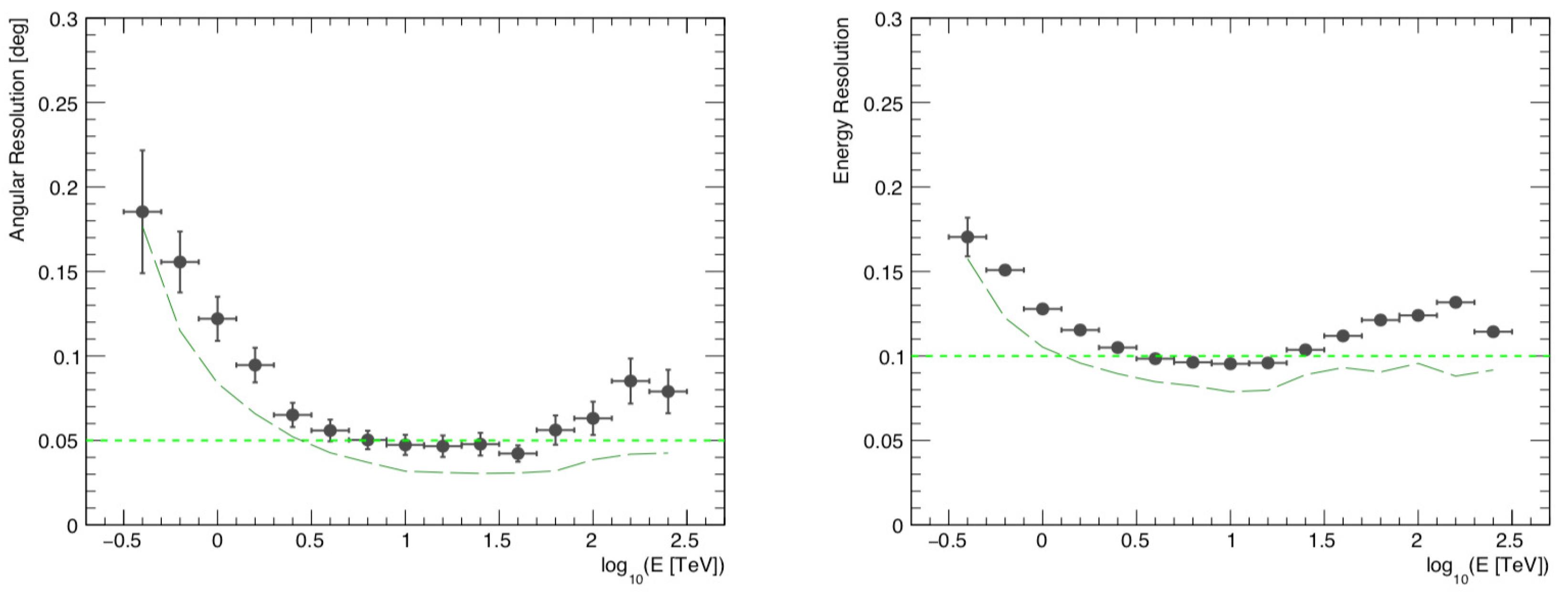
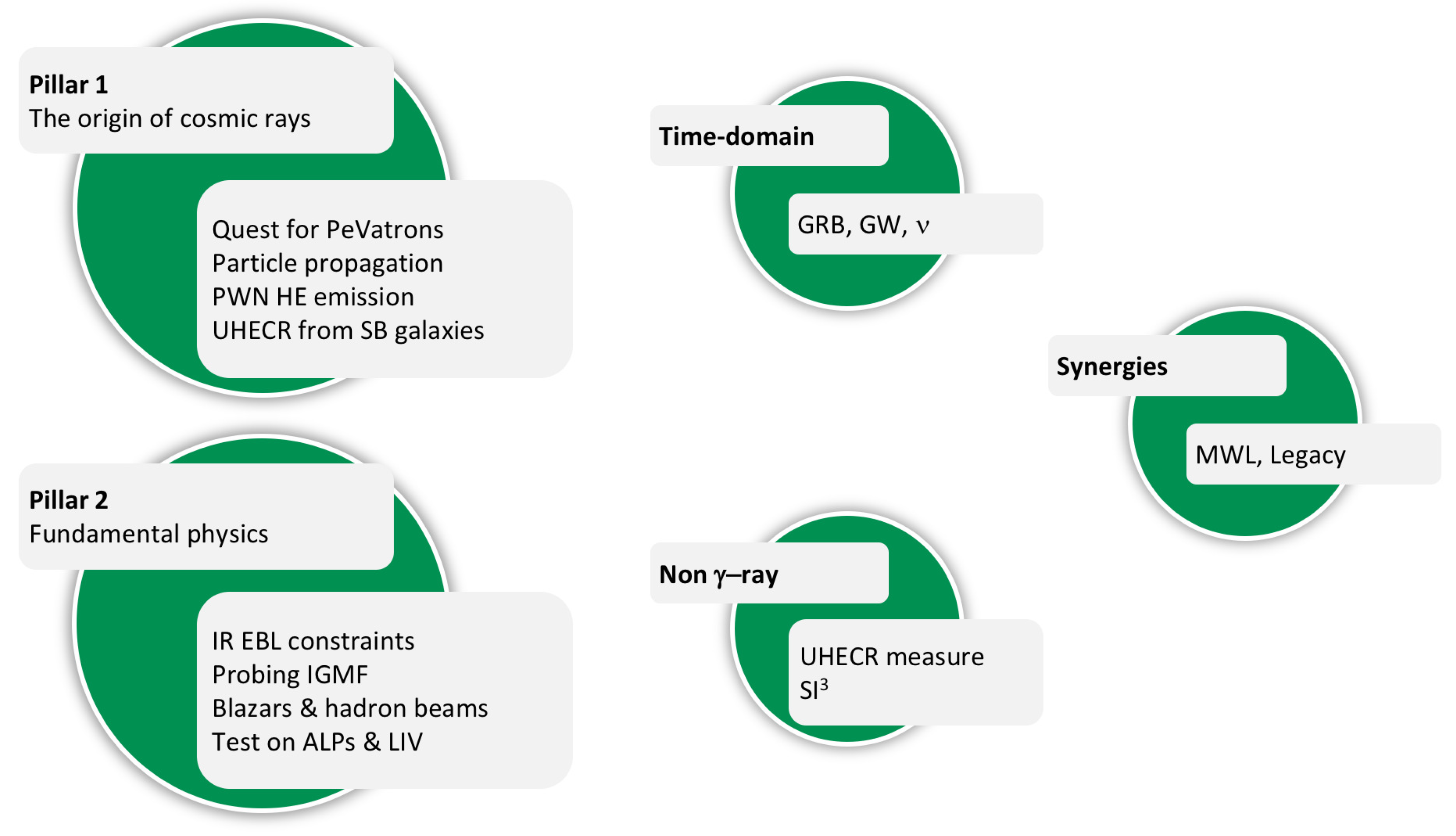

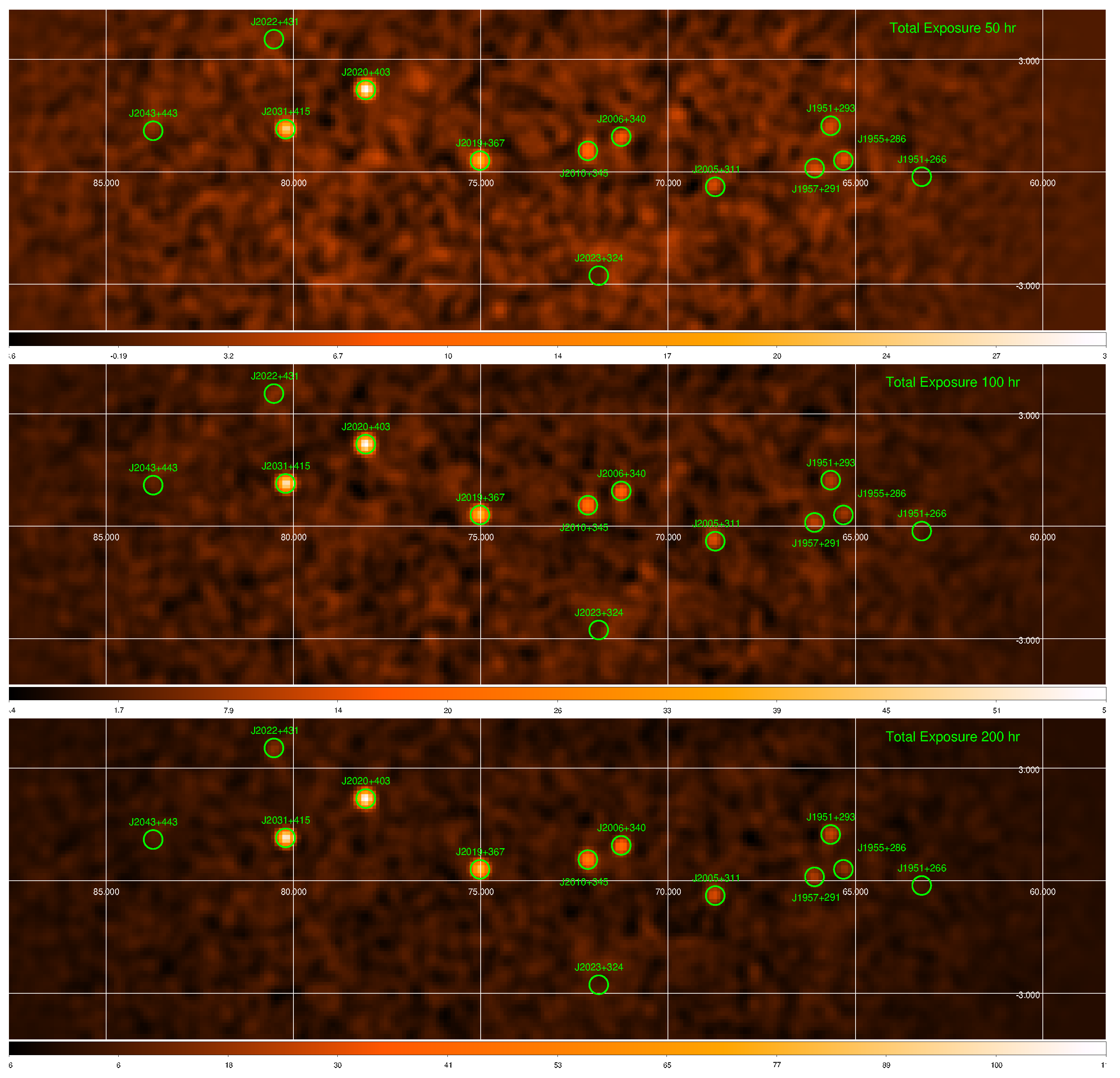

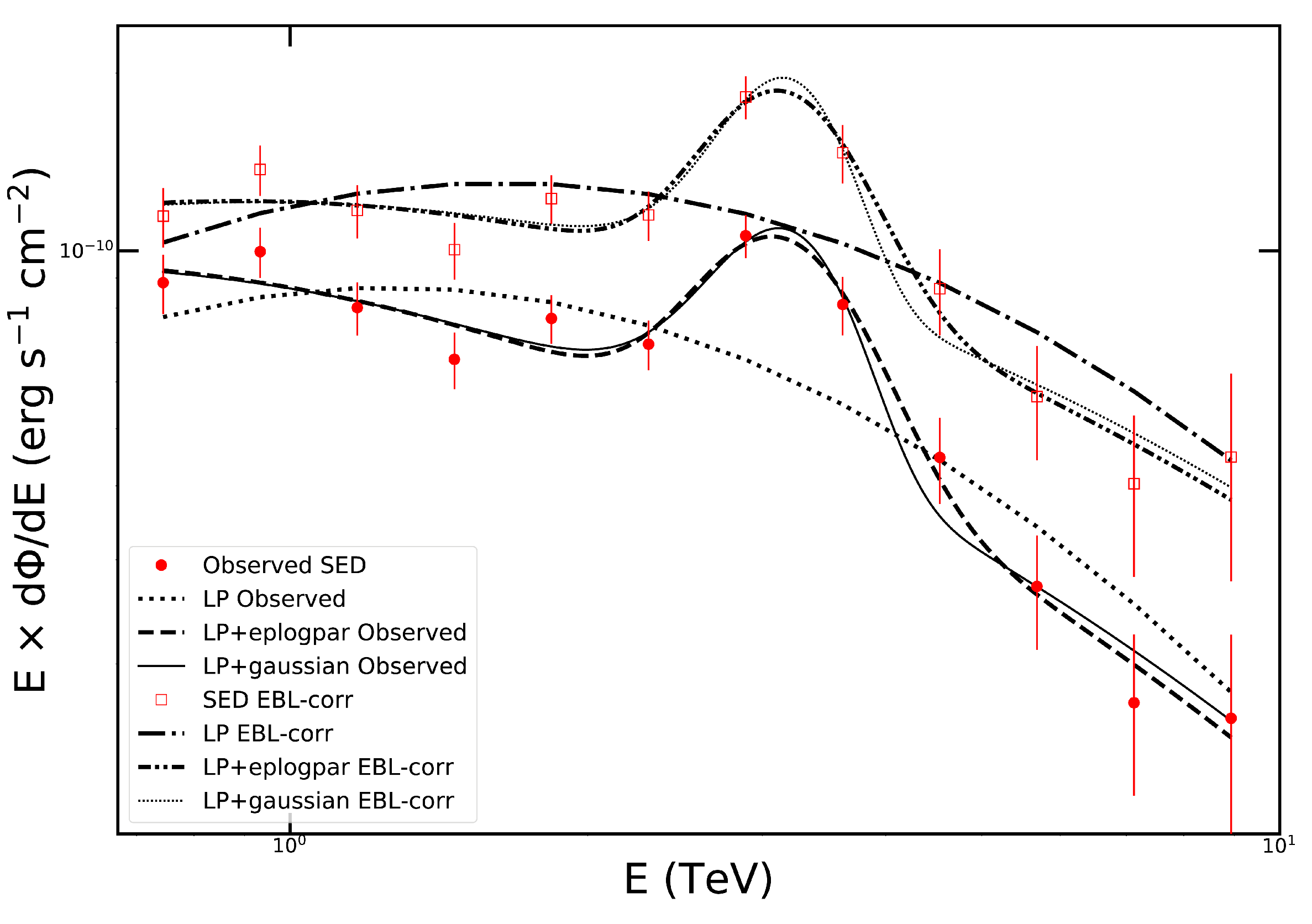
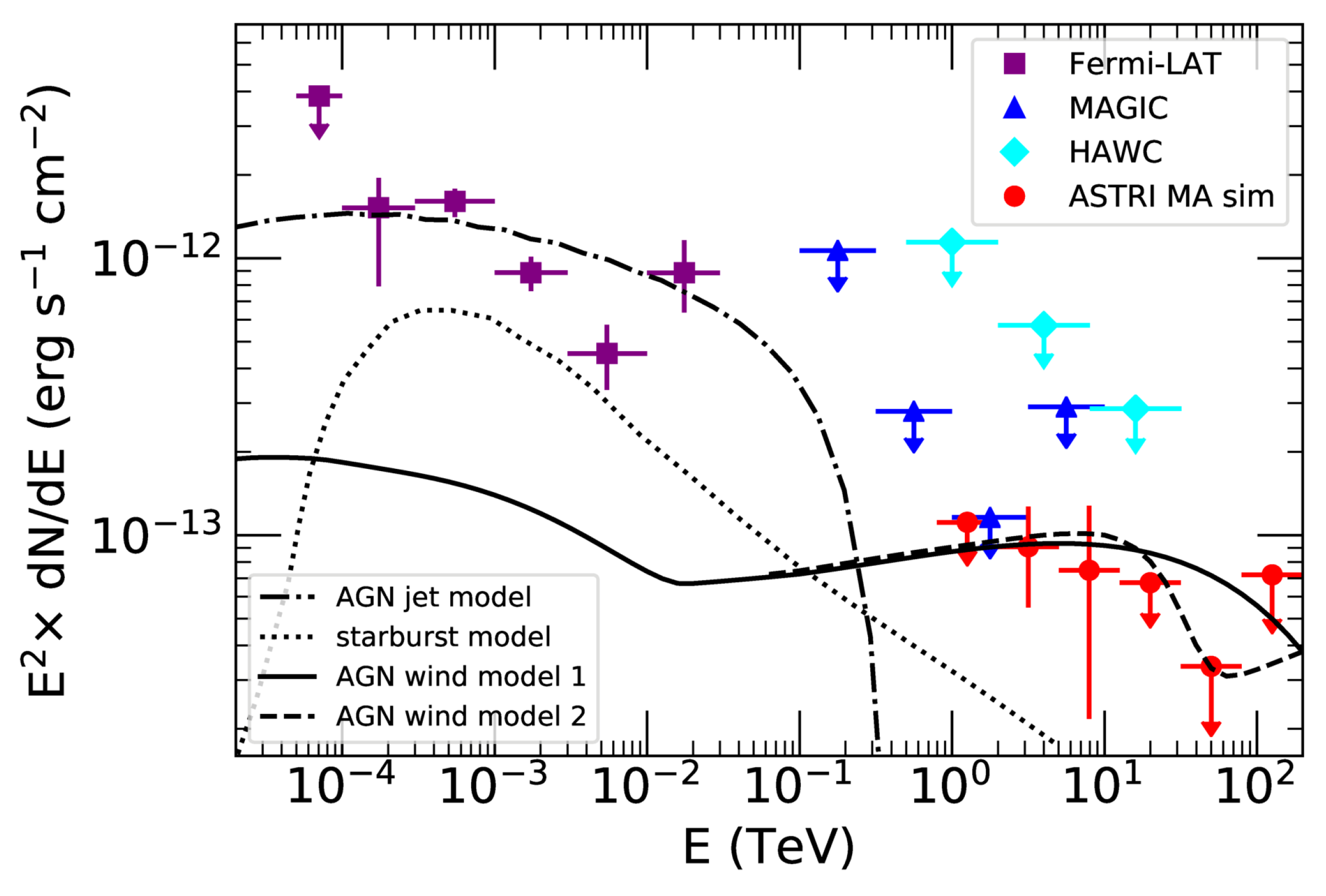
| Quantity | ASTRI Mini-Array | MAGIC | VERITAS | H.E.S.S. |
|---|---|---|---|---|
| Location | 28° 18 04 N | 28° 45 22 N | 31° 40 30 N | 23° 16 18 S |
| 16° 30 38 W | 17° 53 30 W | 110° 57 7.8 W | 16° 30 00 E | |
| Altitude [m] | 2390 | 2396 | 1268 | 1800 |
| FoV | ° | ° | ° | ° |
| Angular Res. | ° (10 TeV) | 0.07° (1 TeV) | 0.07° (1 TeV) | 0.06° (1 TeV) |
| Energy Res. | 10% (10 TeV) | 16% (1 TeV) | 17% (1 TeV) | 15% (1 TeV) |
| Energy Range | (0.5–200) TeV | (0.05–20) TeV | (0.08–30) TeV | (0.02–30) TeV |
| Quantity | ASTRI Mini-Array | HAWC | LHAASO | Tibet AS- |
|---|---|---|---|---|
| Location | 28° 18 04 N | 18° 59 41 N | 29° 21 31 N | 30° 05 00 N |
| 16° 30 38 W | 97° 18 27 W | 100° 08 15 E | 90° 33 00 E | |
| Altitude [m] | 2390 | 4100 | 4410 | 4300 |
| FoV | ∼0.024 sr | 2 sr | 2 sr | 2 sr |
| Angular Res. | ° (10 TeV) | 0.15° (10 TeV) | (0.24–0.32)° (100 TeV) | 0.2° (100 TeV) |
| Energy Res. | 10% (10 TeV) | 30% (10 TeV) | (13–36)% (100 TeV) | 20% (100 TeV) |
| Energy Range | (0.5–200) TeV | (0.1–1000) TeV | (0.1–1000) TeV | (0.1–1000) TeV |
Disclaimer/Publisher’s Note: The statements, opinions and data contained in all publications are solely those of the individual author(s) and contributor(s) and not of MDPI and/or the editor(s). MDPI and/or the editor(s) disclaim responsibility for any injury to people or property resulting from any ideas, methods, instructions or products referred to in the content. |
© 2024 by the author. Licensee MDPI, Basel, Switzerland. This article is an open access article distributed under the terms and conditions of the Creative Commons Attribution (CC BY) license (https://creativecommons.org/licenses/by/4.0/).
Share and Cite
Vercellone, S., on behalf of the ASTRI Project. Science with the ASTRI Mini-Array: From Experiment to Open Observatory. Universe 2024, 10, 94. https://doi.org/10.3390/universe10020094
Vercellone S on behalf of the ASTRI Project. Science with the ASTRI Mini-Array: From Experiment to Open Observatory. Universe. 2024; 10(2):94. https://doi.org/10.3390/universe10020094
Chicago/Turabian StyleVercellone, Stefano on behalf of the ASTRI Project. 2024. "Science with the ASTRI Mini-Array: From Experiment to Open Observatory" Universe 10, no. 2: 94. https://doi.org/10.3390/universe10020094
APA StyleVercellone, S., on behalf of the ASTRI Project. (2024). Science with the ASTRI Mini-Array: From Experiment to Open Observatory. Universe, 10(2), 94. https://doi.org/10.3390/universe10020094






